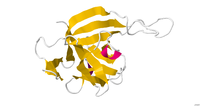
Photo from wikipedia
This case-control study aimed to investigate potential associations between interleukin (IL) gene polymorphisms and the risks of developing extremity posttraumatic osteomyelitis (PTOM) in Chinese Han population. Altogether, 189 PTOM patients… Click to show full abstract
This case-control study aimed to investigate potential associations between interleukin (IL) gene polymorphisms and the risks of developing extremity posttraumatic osteomyelitis (PTOM) in Chinese Han population. Altogether, 189 PTOM patients and 200 healthy controls were genotyped of IL-1α (rs17561, rs1800587), IL-1β (rs16944, rs1143627, rs1143634, rs2853550), IL-1RN (rs4251961, rs419598, rs315951), IL-4 (rs2243248, rs2243250), IL-6 (rs1800795, rs1800796, rs1800797), IL-8 (rs4073, rs2227306, rs2227307), IL-10 (rs3024491, rs3024496, rs1800871, rs1800872, rs1800896), IL-17A (rs2275913), and IL-17F (rs763780) using the SNaPshot genotyping method. Statistical differences were observed regarding the genotype distributions of rs16944 (P = 0.049) and rs4251961 (P = 0.007) between the patients and healthy controls. In addition, significant associations were found between rs16944 and the risk of PTOM development by dominant (OR = 1.854, P = 0.017), homozygous (OR = 1.831, P = 0.041), and heterozygous (OR = 1.869, P = 0.022) models, and of rs1143627 by dominant (OR = 1.735, P = 0.032) and homozygous (OR = 1.839, P = 0.040) models. Moreover, significant links were also identified between rs4251961 and the susceptibility to PTOM by dominant (OR = 0.446, P = 0.005) and heterozygous (OR = 0.409, P = 0.003) models, and of rs1800796 by dominant (OR = 4.184, P = 0.029), homozygous (OR = 4.378, P = 0.026), and heterozygous (OR = 3.834, P = 0.046) models. The present outcomes demonstrated that rs16944, rs1143627, and rs1800796 associate with increased risks, while rs4251961 links to a decreased risk of PTOM development in Chinese Han population.
Journal Title: Mediators of Inflammation
Year Published: 2020
Link to full text (if available)
Share on Social Media: Sign Up to like & get
recommendations!